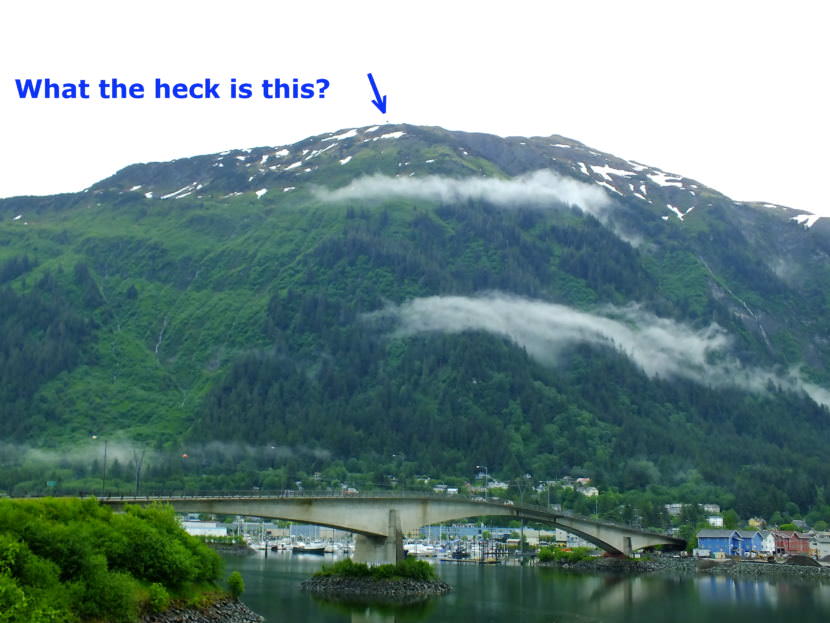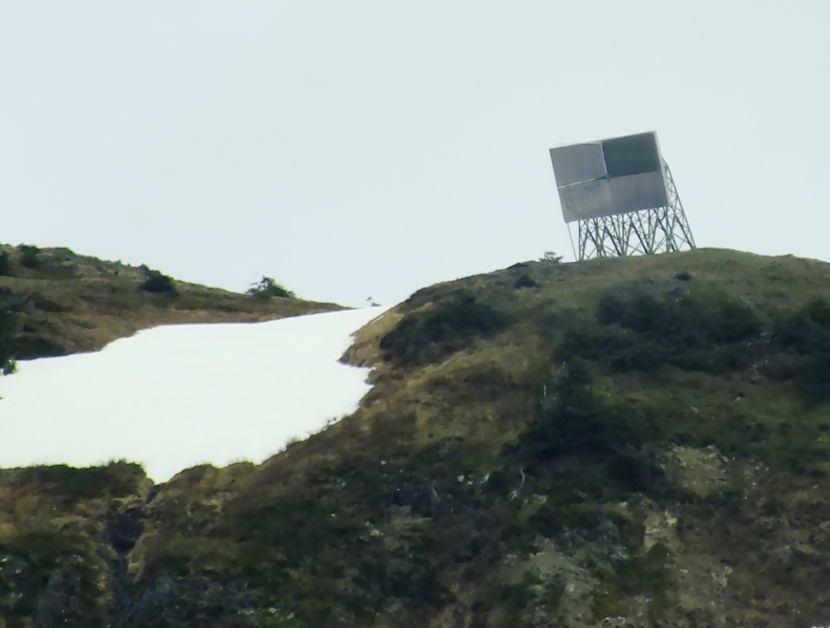
In this edition of Curious Juneau, we answer a question about one of the Capital City’s most imposing landmarks: Mount Juneau.
Listener Chris Murray writes, “What in the world is that billboard looking structure on top of Mt. Juneau that can be seen from all over downtown and Douglas?”

If you look through binoculars, you can see what appears to be a large metal frame subdivided into four smaller panels and angled slightly downward.

Curious Juneau stars you and your questions. Every episode we help you find an answer. Catch up on past episodes, or ask your own question on the Curious Juneau page.
Listen to the Curious Juneau segment about the microwave reflector:
It certainly looks like a billboard or perhaps a drive-in movie theater screen. The assembly is held up by what appears to be a metal support framework.
We checked with the City and Borough of Juneau, and their cartographer Quinn Tracy said the structure is probably 25 feet wide by 16 feet high, based on a light detection and ranging, or LIDAR, survey done in 2013.
After checking property maps, we discover that the panel sits on an L-shaped parcel at an elevation of 3,012 feet. The owner is listed as AT&T in New Jersey.
We tracked down somebody with AT&T Alascom who told us it was used as a passive repeater for microwave communication signals.
Alascom used to beam telephone and video signals from their downtown office about 1.4 miles up to the panel. The signals were reflected nearly 14 miles to a satellite uplink station at Lena Point.
Our source at AT&T Alascom did not want to be identified or quoted because he didn’t have permission to speak for the company. And, no one at their Anchorage offices got back to us.
So, we turned to Gray Haertig, an electrical engineering consultant based out of Portland, Oregon, who also worked on the White Alice communications system in Hoonah during the Cold War.
(Gray Haertig works as a consultant for several public radio stations in Alaska, including KTOO.)
He explained that telephone lines were impractical over long distances with no roads.
High frequency radio had limited capacity and only one call could be made at a time.
“In the mid- to late-50s, AT&T developed microwave systems, which operated at a much higher frequency,” said Haertig, who works as a consultant for several public radio stations in Alaska, including KTOO. “That system probably operated in the 2 gigahertz region.”
Microwaves could carry multiple telephone channels at once. But there was one big drawback.
“At 2 gigahertz, radio waves don’t go around corners very well. If you run into dirt, they stop,” Haertig said. “They had to figure out a way to get a signal from one place to another place when there was no way to see them, see one end to the other.”
Haertig wasn’t sure when the reflector was installed on Mount Juneau, but this is how it worked.
“If you imagined that the reflector was a mirror – nice and shiny and optically wonderful – if you stood at one end of the microwave path and somebody else stood at the other end of the microwave path and you got out your binoculars, you should be able to see each other. That’s how these things worked. (They) worked effectively optically even though it was microwave frequencies.”
The microwave signal from downtown Juneau would be sent up and bent down to the receiver at Lena Point.
Haertig said microwave communications later gave way to satellites in the 1970s and then fiber optic cable. The reflector was probably last used in the 1990s, even though AT&T Alascom still holds a license for it.
Coincidentally, the old AT&T Alascom public telegraph office in downtown Juneau is now the KTOO building.
